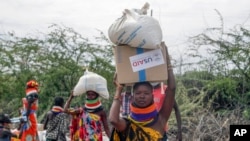The United States aid agency USAID says Kenya's drought has reached the point of farmers losing up to 70 percent of their crops and at least 2.4 million livestock deaths were reported in May.
Danielle Resnik is a fellow at the International Food Policy Research Institute. She cites climate change as a major contributor to food insecurity in Kenya.
“For example we've seen rainfall being 55 percent less than average just between March and May of this year. And this, of course, contributes to poor vegetation less available for grazing for livestock. We've seen thousands of livestock deaths, and milk production has been about 60 percent below its average.”
Resnik also points out that almost 47 percent of Kenya’s wheat and 45 percent of edible oils are imported, so their prices have jumped, while prices of fertilizer – which Kenya depends on – have gone up globally by about 30 percent since January.
Although the US is providing nearly $235 million in additional humanitarian assistance to meet urgent needs for more than 1.1 million people across Kenya, more funding will be needed to help prevent significant loss of life and to meet expected humanitarian needs well into 2023.
USAID is urging the international community to join in scaling up assistance to save lives.
Many families have yet to fully recover from the devastating effects of the COVID-19 pandemic and other climatic shocks before Russia’s war on Ukraine further exacerbated the hunger crisis with a rise in food, fuel and fertilizer prices.
“Given the impacts of the Russian war, resources will be very important. The United States government recognizes that and appreciates the front-line work that is being done here and will continue to press for additional resources to be made available,” said Michael Bittrick, senior advisor in the global global food security office at the State Department
In fiscal year 2022 alone, the United States has provided nearly $324 million in humanitarian assistance to the people of Kenya – the greatest share of all donor funding to date. But more funding will be needed to help prevent significant loss of life and to meet expected humanitarian needs well into 2023.









